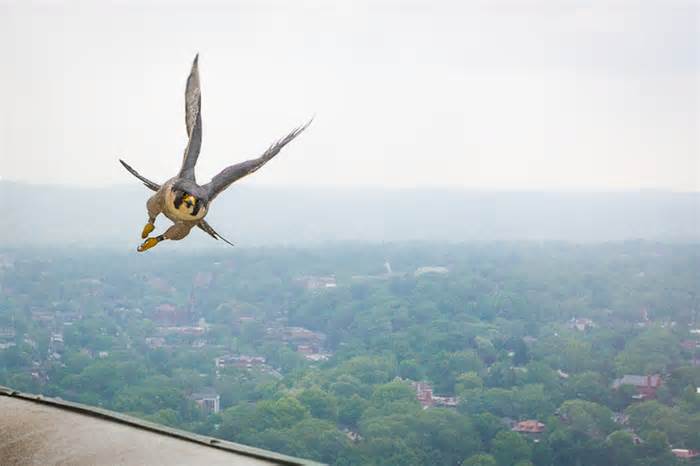Read Kate St. John’s blog, Out My Window.
Nestcams and Wildlifecams Pennsylvania:
###
Ah, spring! The time of year when we are glued to our computers and mobile phones watching webcams pointing at the nests of prominent birds of prey. We are completely engrossed as they are born and raising their fur babies.
I’ve been watching Nestcams for over a decade, ever since I helped install my favorite camera: the Peregrine Falcon camera at the University of Pittsburgh’s Cathedral of Learning. He went online in 2003 because he wanted to keep an eye out for Dorothy and Erie, the first pair of basking sharks to nest there.
I did it because I was frustrated. I am the official instructor for Pitt’s peregrine falcons, so my task each spring is to track egg laying and notify the Pennsylvania Game Commission when the eggs hatch. It is difficult to do without a camera because the nest is on an inaccessible edge. of a 40-story building. It cannot be seen from any window or from the floor. But thanks to the camera, I know the moment each egg is laid in the gravel container they scraped to make a nest. I am hooked.
Over the years, the generation has advanced dramatically, and so has the popularity of Nestcam. I’m one of the few spectators. I am now part of a network of thousands. Before, I just watched. I am now a blogger and the self-proclaimed “pilgrim lady” of Pittsburgh. That gave me an attitude from both sides of the camera.
Most birds refuse to nest in the sight of humans, but we camera watchers are delighted to see and hear the tiny thumps of a chick from its reddish-brown shell.
But the Nestcam also shows us everything: the good, the bad, and the ugly. And when the Nestcam family finds itself in trouble, such as when an egg doesn’t hatch, it can get excited. This is where I can help and reassure other people that what scares us isn’t so bad for peregrine falcons.
This is because the lives of pilgrims are very different from ours. Using our human criteria to perceive them – anthropomorphization – leads us astray. For example, pilgrims are not sociable: they never form herds and care more about their territory than their peers. They will not protect themselves in bloody battles and will without delay join the victor. Pilgrims do not grieve.
In times of drama, the public calls for intervention or thinks that, as in real television, public votes will replace the result. But if humans intervene, the pilgrims damage the place and leave. And then, we’ll never be able to see them again in front of the camera.
To others I say with patience and honesty: if the sight of it bothers you, turn it off. Get some rest. Yes.
And I also get stuck in the moment. I write about them as if they were human. But I realize it and I say, “Wait. Show. Look what happens. Don’t miss what’s really going on. “
There’s a lot more to their lives than what we see on camera. Their vision is very narrow. You don’t even see them perched on the nest, watchful, like gargoyles. A Nestcam never shows us the most productive aspects of peregrine falcons, such as their impressive hunting dives. They fall from the sky like a ball, righting themselves at the last moment to catch their prey in mid-air in an explosion of feathers. They never do anything by halves.
Are Nestcams worth the emotional roller coaster? They make us take care of a species that we wouldn’t otherwise know about. But we don’t really belong in their nest. Our role is to help protect bird habitat, from forests to our gardens, so that the basking birds and sharks that depend on them for food can thrive.
That’s what the camera helps us see. Also, at my point of obsession, I couldn’t continue a nesting season without it.

